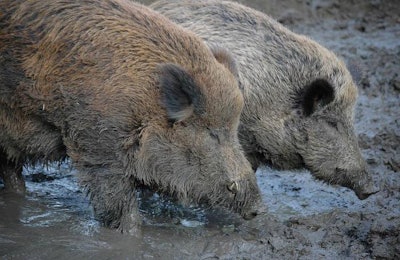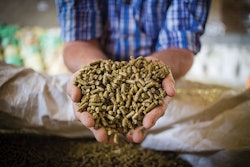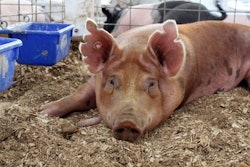
New outbreaks of African swine fever (ASF) have been officially reported to the global monitoring agency in domestic pigs in Mongolia, Romania and Ukraine, while the causative virus has also been detected recently in the wild boar populations of Belgium, Latvia, Poland and Romania.
Over the past week, there were 12 new outbreaks of ASF in domestic pigs in Europe — Romania (9), Ukraine (2) and Poland (1) — according to the most recent Animal Disease Notification System report from the European Commission (EC). In addition, there were 174 outbreaks reported in wild boar, including 71 in Poland, 32 in Lithuania, 25 in Hungary, and 18 in Belgium over the same period.
Reports lodged in the past week by the national veterinary agencies to the global monitoring agency, World Organisation for Animal Health (OIE), cover varying periods of time from the EC.
Latest reports from Romania’s Sanitary Veterinary and Food Safety Authority to the OIE indicate 21 new outbreaks in domestic pigs in recent weeks. All affected herds are described as “backyard” units, in which 287 animals were lost to the disease through mortality or culling.
The majority of these outbreaks were in counties in the south and west of the country, as were the 238 sick and dead wild boar that tested positive for the ASF virus at 40 locations over the same period, based on the same official reports to the OIE.
One bright spot in Romania’s battle against ASF is that the disease situation has been “resolved” in the county of Dolj in the southwest of the country, after just one outbreak of the disease there in October 2018.
Another European country where the ASF situation appears to be being brought under control is Poland. Despite confirming to the OIE a total of 80 outbreaks of ASF in its northern and eastern province during December, the Ministry of Agriculture and Rural Development considers the situation in these regions “resolved,” because all these cases were in wild boar in areas subject to ASF restrictions under European Union legislation.
Latest reporting of the National Food Safety Agency of the Republic of Moldova to the OIE points to a partial resolution of the ASF disease situation. The move comes after a period of at least two months without any outbreaks among the country’s wild boar population in two out of three affected regions.
These announcements should be treated with some caution as ASF has recurred in some areas where the situation had been thought to be under control.
Ukraine is a recent example. At the end of January, the State Service on Food Safety informed OIE about two new outbreaks of the disease after a two-month apparent absence. In the southeastern province of Donetsk, the virus was detected among six pigs in a backyard herd, as well as in a pig carcass dumped at Mikolaiv in Nikolayev oblast in the south of the country.
Europe’s wild boar: ASF detection, control measures
Further ASF outbreaks have been confirmed in the wild boar population of Belgium’s southern region of Luxembourg. A total of 31 animals found at 18 locations in the province tested positive for the virus in the most recent weekly update from the country’s animal health agency, the Federal Agency for the Safety of the Food Chain (FASFC), to the OIE.
In the most recent update to its own website, FASFC said 345 of the 1,058 wild boar carcasses officially tested were positive for the ASF virus.
The agency stresses that there have been no cases of the disease so far in domestic pigs in Belgium. The “high-risk” zone was cleared of all domestic pigs by November last year, and the 16 farms in the surrounding “vigilance zone” are subject to intensive surveillance.
A further 14 wild boar at 13 locations in Latvia tested positive for the ASF virus during the third week of January, according to the latest report from the agriculture ministry to the OIE.
This week, Denmark carried out a four-day emergency exercise to test the country’s preparedness in case of an outbreak in its pig population, according to the Danish Veterinary and Food Administration. If the disease were to enter the Danish pig industry, the same agency estimates it would lead to a loss of exports earnings of at least DKK2.5 billion (US$384 billion), up to a possible DKK11 billion.
To control the wild boar population and thus minimize the risk of ASF entering the country, the German Hunting Association reports that a record number of the animals have been shot in the latest hunting season, according to Deutsche Welle.
Asia: ASF spreads to new areas of Mongolia
The number of outbreaks in Mongolia since early January has doubled to 10, with cases at five new locations reported by the country’s agriculture ministry to the OIE over the past week.
All the most recent cases were in herds described as “backyard,” but a total of 505 animals were lost to the disease directly through mortality or culling after detection of the virus. Since the first case was reported in early January, 1,148 pigs have been affected by ASF in six of the country’s northern and central provinces.
China’s veterinary authority has not informed OIE about any new ASF cases during the past week. A recent report from the United Nations’ Food and Agriculture Organization (FAO) dated January 25 records a total of 104 confirmed outbreaks of the disease in the People’s Republic since August 2018, and more than 916,000 pigs culled to control the spread of the infection.
View our continuing coverage of the African swine fever outbreak.


















